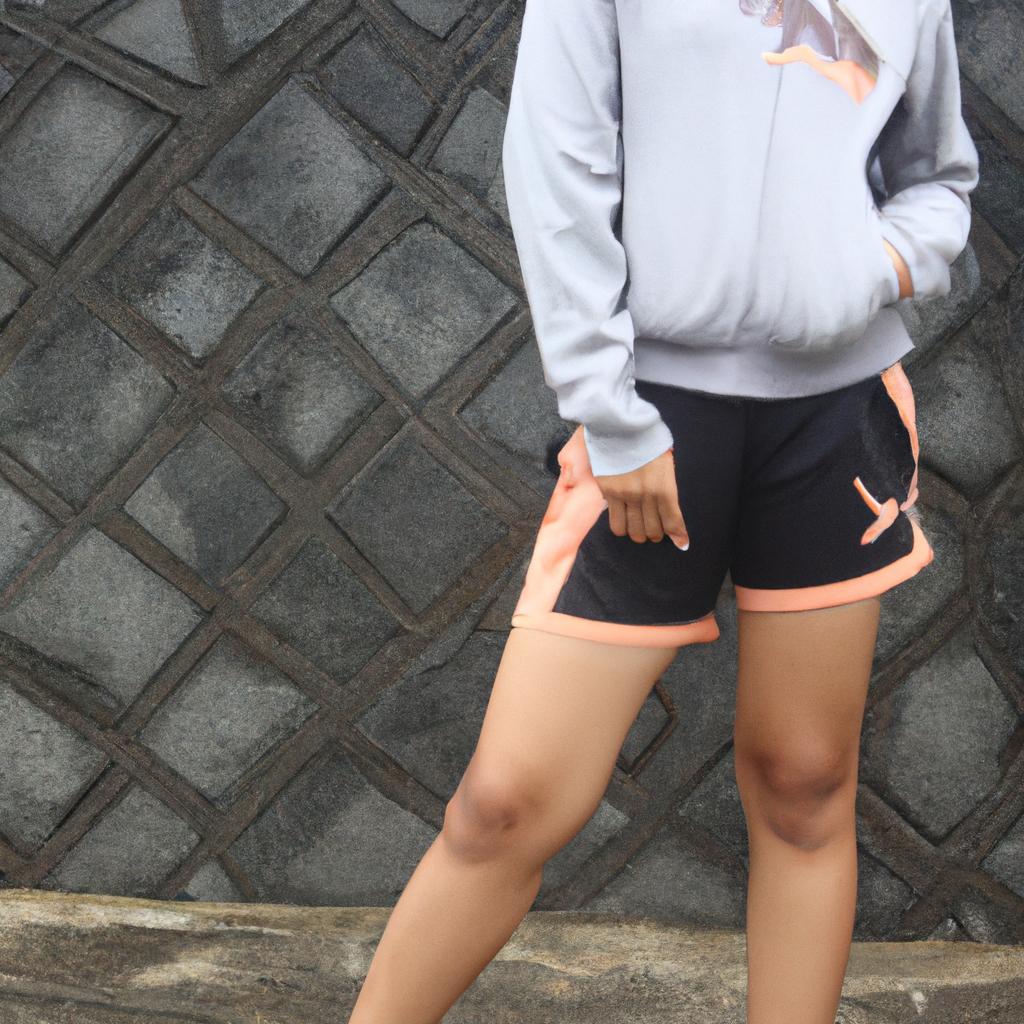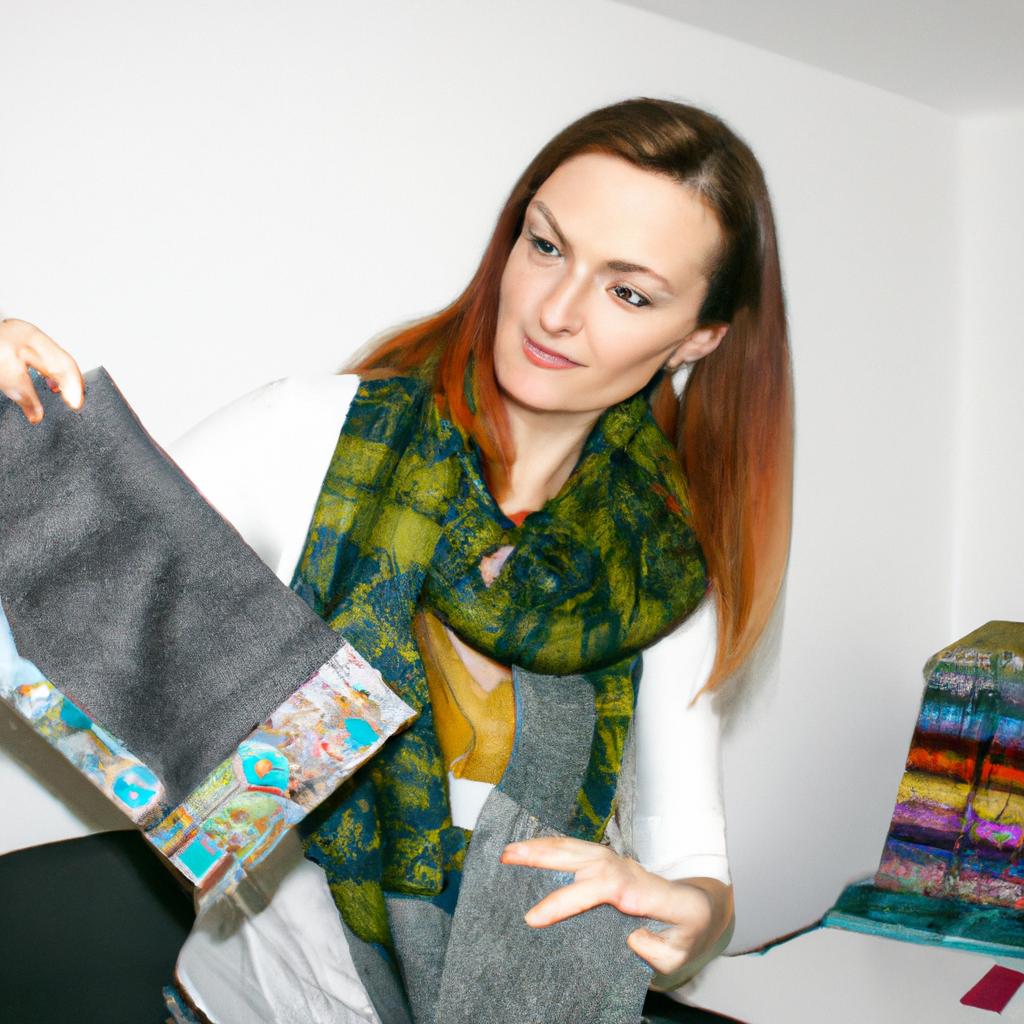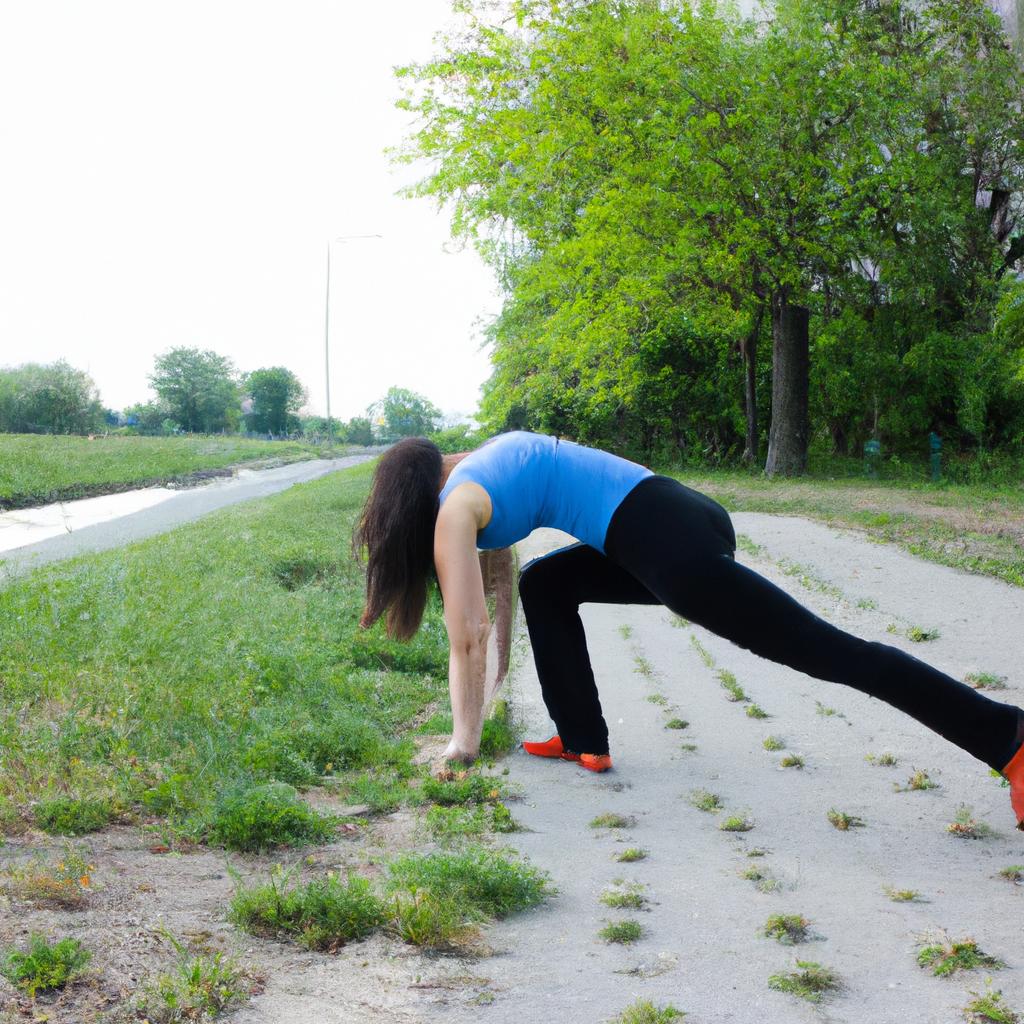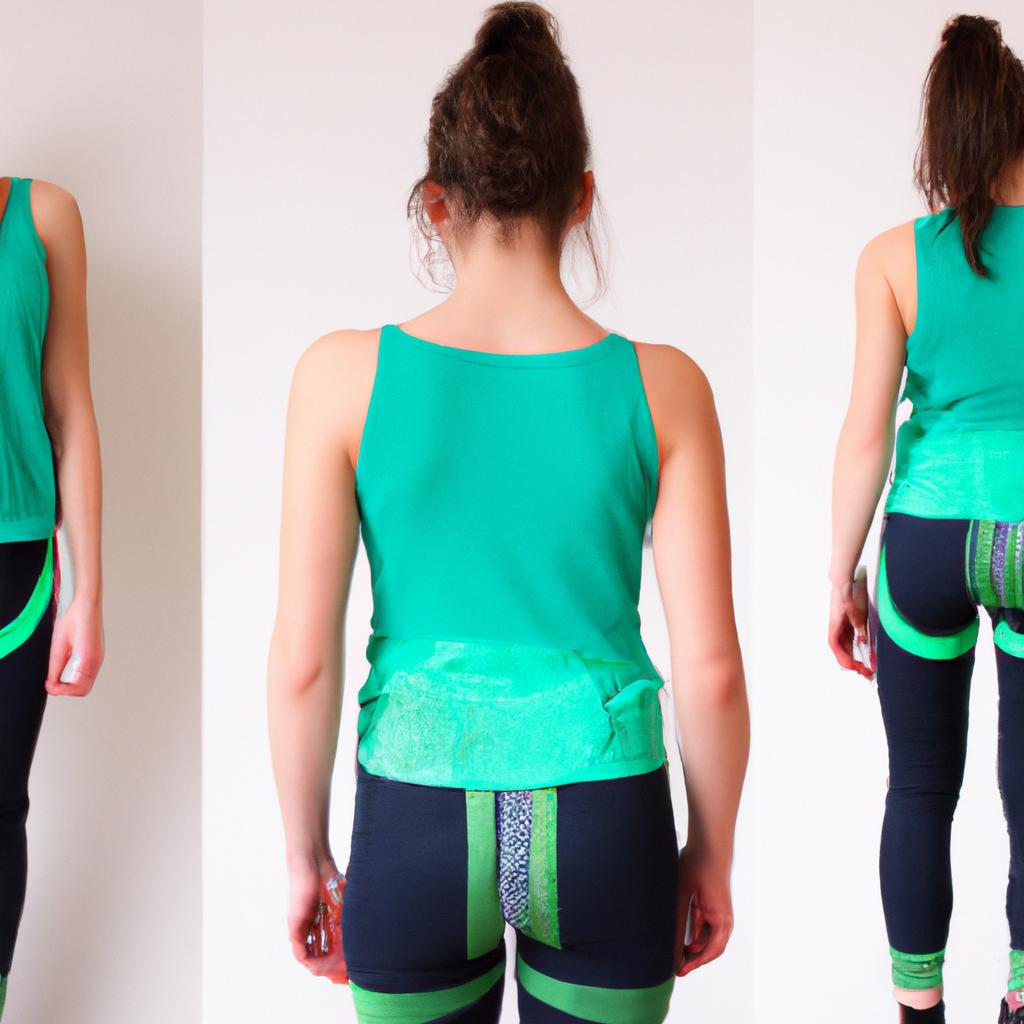Sizing Guide: Women’s Activewear – Informative
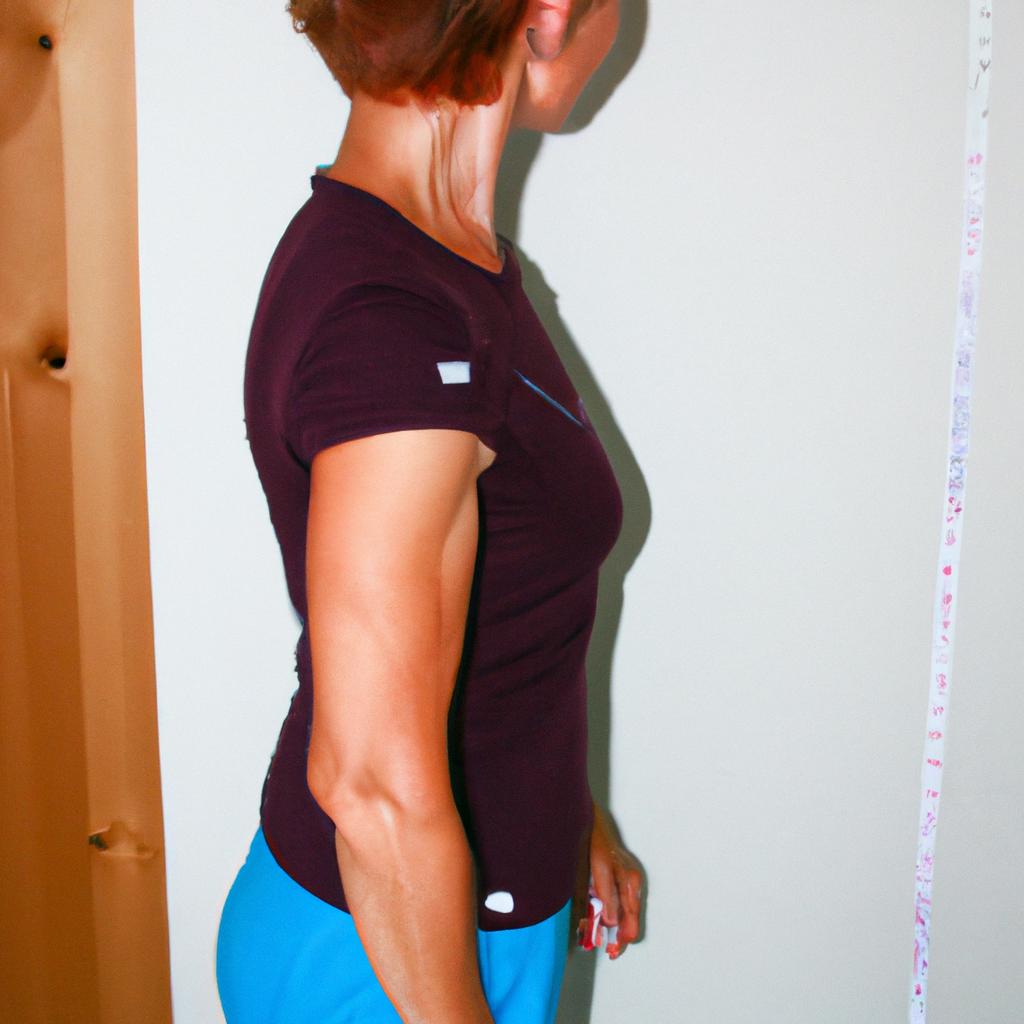
The proper sizing of women’s activewear is crucial for ensuring comfort, functionality, and optimal performance during physical activities. In today’s market, with an abundance of options available to consumers, understanding how to determine the correct size can be overwhelming. For instance, imagine a woman who is preparing for her first marathon; she purchases a pair of running tights that are too loose around the waistline. As she starts running, she finds herself constantly pulling up her pants, which distracts her from focusing on her pace and form. This scenario highlights the importance of having access to accurate sizing guidance when selecting activewear.
This article aims to provide an informative guide on determining the appropriate size in women’s activewear. By adopting an academic writing style devoid of personal pronouns, this piece will present research-based information and expert opinions that shed light on various aspects related to sizing guidelines for different types of athletic clothing. The discussion will encompass not only key measurements such as bust, waist, and hip circumference but also considerations specific to activewear materials and styles. Through exploring these factors comprehensively, readers will gain valuable insights into making well-informed decisions while purchasing women’s activewear garments that promote both comfort and functionality during sports and fitness activities.
Understanding Women’s Activewear Sizing
Imagine this scenario: Sarah, an avid runner, decides to buy a new pair of leggings for her daily workouts. She goes online and finds a size chart that indicates she should wear a medium based on her hip measurements. Excitedly, she places the order and eagerly awaits the arrival of her new activewear. However, when the package arrives, Sarah is disappointed to find that the leggings are too tight around her waist. Frustrated and confused, she wonders why the sizing chart let her down.
Understanding women’s activewear sizing can be complex and often confusing. It is essential to recognize that there is no universal standard for sizing across brands or even within different product lines from the same brand. As such, it becomes crucial for individuals like Sarah to familiarize themselves with how specific brands measure their garments in order to make informed choices.
To help navigate through this complexity, here are some key points to consider:
- Vanity Sizing: Many women’s activewear brands employ vanity sizing techniques where they label clothing sizes smaller than they actually are. This marketing strategy aims to boost customers’ self-esteem by making them believe they fit into a smaller size than expected.
- Fit Consistency: Even within one brand, not all clothing items may have consistent sizing standards. For instance, while you might usually wear a medium-sized top from a particular brand comfortably, you may need to choose a large-sized bottom for proper fitting.
- Body Shape Variation: Different people have varying body shapes (hourglass, apple-shaped, pear-shaped), which impact how clothing fits them despite having similar measurements. It is important to understand your own body shape as well as any specific recommendations provided by the brand regarding their garment designs.
- Fabric Stretchability: Some activewear fabrics possess more stretch compared to others due to factors such as material composition or construction technique. This variation affects how the garment conforms to different body shapes and sizes.
To illustrate further, consider the following table that demonstrates hypothetical measurements for three individuals wearing a size medium in the same brand of leggings:
| Waist (inches) | Hip (inches) | |
|---|---|---|
| Individual A | 28 | 38 |
| Individual B | 30 | 40 |
| Individual C | 32 | 42 |
As shown, even though all three individuals wear a medium, their waist and hip measurements can vary significantly. This highlights the importance of considering multiple key measurements rather than relying solely on one measurement when determining your activewear size.
In summary, understanding women’s activewear sizing requires recognizing the lack of universal standards across brands, being aware of vanity sizing practices, acknowledging variations within a single brand’s product lines, considering individual body shape differences, and accounting for fabric stretchability.
Key Measurements to Consider
To ensure a comfortable fit and optimal performance, it is crucial to understand the sizing of women’s activewear. Let us consider an example: Sarah, an avid runner, recently purchased a pair of running tights online. Despite referring to the size chart provided by the retailer, she was disappointed with the fit when they arrived. This scenario highlights the importance of understanding key measurements that influence women’s activewear sizing.
When determining your size for women’s activewear, there are several important measurements to keep in mind:
- Bust: Measure around the fullest part of your bust.
- Waist: Find the narrowest part of your waist and measure around it.
- Hips: Measure around the widest part of your hips.
- Inseam: Determine the length from your crotch to just below your ankle bone.
These measurements can serve as helpful indicators when selecting the appropriate size for different types of activewear garments such as leggings, sports bras, or tops. By taking these measurements into account, you can make more informed decisions about which size will provide a better fit and enhance your overall athletic experience.
In addition to understanding these key measurements, it can be useful to refer to specific brand sizing charts whenever available. Each brand may have slight variations in their sizing standards, so consulting their charts can help guide you towards selecting the most suitable size for your body type.
Now that we have explored how key measurements play a vital role in women’s activewear sizing let us focus on choosing the right size specifically for tops. The next section will delve deeper into this aspect and provide valuable insights on finding tops that offer both comfort and functionality during physical activities without compromising style or range of motion. So whether you’re searching for a new tank top or a long-sleeved hoodie, understanding how to choose the correct size will help you make the most out of your activewear wardrobe.
Choosing the Right Size for Tops
When it comes to finding the perfect fit for women’s activewear, there are a few key measurements that you should consider. These measurements will help ensure that your tops and bottoms fit comfortably and allow you to move freely during your workouts. Let’s take a closer look at these important measurements.
One example of a crucial measurement is the bust size. This measurement determines the circumference around the fullest part of your chest. It is essential in determining the right size for sports bras or tops with built-in support. For instance, let’s imagine Sarah, who has a bust size of 36 inches. Based on this measurement, she can refer to our sizing chart to find her ideal top size.
To assist you further in understanding how different measurements affect sizing decisions, here are some factors to keep in mind:
- Body shape: Different body shapes may require specific adjustments when selecting activewear sizes.
- Fabric stretch: Some fabrics have more stretch than others, so knowing your measurements helps determine which fabric composition suits your preferences.
- Activity level: The type of activity you engage in can impact sizing choices; certain exercises may demand looser fits while others benefit from snugger options.
- Personal preference: Ultimately, everyone has their own unique style and comfort preferences when it comes to activewear.
Now, let’s dive into what each measurement entails and how they contribute to finding the perfect fit for tops:
| Measurement | How to Measure | What it Determines |
|---|---|---|
| Bust | Measure around the fullest part of your chest | Size of tops/sports bras |
| Waist | Measure around the narrowest part of your waist | Fit around waist area |
| Hips | Measure around the widest part of your hips | Fit around hip area |
| Inseam | Measure from crotch seam down to desired pant length | Length of pants/leggings |
By considering these key measurements and understanding how they contribute to finding the right size, you can confidently select tops that will provide both comfort and style for your active lifestyle.
Transitioning seamlessly into our discussion about “Selecting the Perfect Fit for Bottoms,” let’s now explore how different measurements impact sizing decisions when it comes to activewear bottoms.
Selecting the Perfect Fit for Bottoms
When it comes to choosing the right size for women’s activewear bottoms, there are a few key considerations to keep in mind. Just like with tops, finding the perfect fit is crucial for optimal comfort and performance during your workout sessions. Let’s explore some tips that will help you make an informed decision.
To begin, let’s consider an example scenario. Imagine you’re searching for a pair of leggings to wear during your yoga classes. You want them to be snug enough to provide support and flexibility but not so tight that they restrict your movement. By following these guidelines, you can ensure a comfortable fit:
- Look for a waistband that sits comfortably on your hips without digging in or slipping down.
- Pay attention to the length of the leggings; they should reach just above your ankle or at a length that feels most flattering to you.
- Consider the fabric composition; opt for materials that offer both stretch and breathability for maximum comfort.
- Take note of any additional features such as pockets or mesh panels that might enhance functionality and style.
Now, let’s delve into a table showcasing different sizes available in women’s activewear bottoms:
| Size | Waist (inches) | Hips (inches) | Inseam Length (inches) |
|---|---|---|---|
| XS | 24-26 | 34-36 | 27 |
| S | 26-28 | 36-38 | 27.5 |
| M | 28-30 | 38-40 | 28 |
| L | 30-32 | 40-42 | 28.5 |
This table provides a general guideline based on waist and hip measurements as well as inseam length. However, it is important to remember that sizing can vary between brands, so always refer to the specific brand’s size chart for accurate measurements.
In summary, selecting the perfect fit for women’s activewear bottoms involves considering factors such as waistband comfort, length, fabric composition, and additional features. By following these guidelines and referring to a brand’s size chart, you can find bottoms that offer both style and functionality. Next, we will move on to finding the ideal size for sports bras.
Finding the Ideal Size for Sports Bras
Imagine you’re heading to your favorite yoga class, excited to practice and feel great. As you slip on your activewear bottoms, you realize they don’t fit comfortably or provide the support you need during movement. To avoid such disappointment, it’s essential to find the perfect fit for your women’s activewear bottoms. Consider these key elements when selecting your ideal size:
-
Waistband: The waistband is a crucial component of any bottom as it provides stability and ensures a secure fit. Look for bottoms with elasticated or adjustable waistbands that can be customized to suit your preferences.
-
Length: The length of your activewear bottoms will depend on personal preference and activity type. Capri-length bottoms are popular for activities like Pilates and cycling, while full-length leggings offer more coverage for activities like running or hiking.
-
Fabric Composition: Different fabrics offer varying degrees of stretch, moisture-wicking capabilities, and breathability. Opt for materials like polyester-spandex blends or nylon-elastane mixes that provide flexibility and keep you dry during workouts.
-
Compression Level: Some women prefer activewear bottoms with compression features that promote muscle recovery by increasing blood circulation. Others may choose looser-fitting options for maximum comfort during low-impact exercises.
Consider this case study: Sarah enjoys high-intensity interval training (HIIT) sessions where she performs dynamic movements like squats and burpees regularly. She prefers her activewear shorts to have a higher compression level to support her muscles throughout the workout.
To help guide your decision-making process further, take a look at the table below highlighting different aspects to consider when selecting the perfect fit:
| Aspect | Importance | Example |
|---|---|---|
| Waistband | Provides stability | Adjustable drawstring waistband |
| Length | Depends on activity type | Full-length leggings for running |
| Fabric | Determines comfort | Polyester-spandex blend for flexibility |
| Compression | Varies by personal preference | Higher compression level for intense workouts |
By considering these factors, you can find activewear bottoms that align with your needs and preferences. Whether you’re a seasoned athlete or just starting on your fitness journey, finding the right fit is crucial in ensuring optimal performance and comfort during workouts.
Tips for Achieving the Best Fit
After understanding the importance of finding the right size for sports bras, let’s now explore some tips and considerations to help you achieve the best fit. Imagine this scenario: Anna is an avid runner who recently purchased a new sports bra online. She carefully followed the sizing guide provided by the brand, but when she tried it on, she found that it was too tight around her chest and caused discomfort during her workout. This situation highlights the need for proper knowledge about finding the ideal size.
To ensure a comfortable and supportive fit, keep in mind these key points:
- Measure your band size accurately: Take a snug measurement around your rib cage just below your breasts. Use this measurement as a starting point to determine your band size.
- Consider cup sizes: Sports bras are available in different cup sizes (e.g., A, B, C), so make sure to select one that corresponds with your bust measurements.
- Try on different styles: Different brands and styles may have varying fits. Experiment with various designs such as compression or encapsulation bras to find what works best for you.
- Adjustable straps and closures matter: Look for sports bras with adjustable features like straps and closures. These allow you to customize the fit according to your comfort level and activity intensity.
Now, let’s delve into more specific guidelines through a table illustrating common issues related to ill-fitting sports bras:
| Common Issue | Description | Solution |
|---|---|---|
| Spillage | Breasts overflowing from cups | Try a larger cup size |
| Band Riding Up | The band moves up rather than staying parallel | Opt for a smaller band size |
| Shoulder Strain | Straps digging into shoulders | Adjust straps or try racerback styles |
| Chafing | Irritation due to friction | Look for bras with smooth seams and soft fabric |
In summary, finding the right size is crucial for a comfortable and well-supported workout experience. By accurately measuring your band size, considering cup sizes, exploring different styles, and paying attention to adjustable features, you can find a sports bra that fits perfectly. Remember to address any common issues such as spillage or chafing by adjusting the size accordingly.
By following these guidelines, Anna was able to exchange her ill-fitting sports bra for one that provided the perfect fit. So go ahead and apply these tips to ensure that your activewear enhances both your performance and comfort during physical activity.


